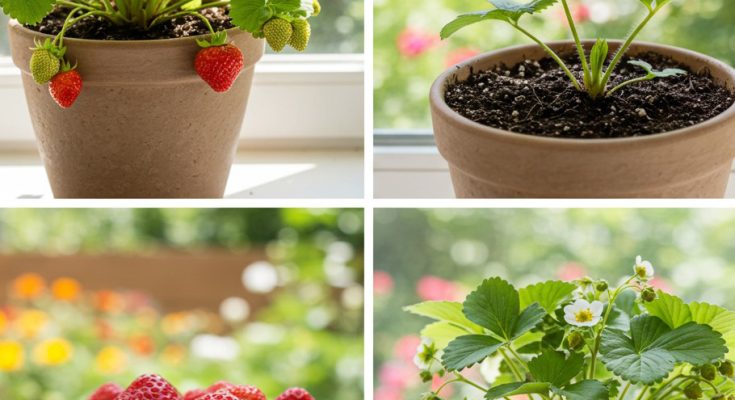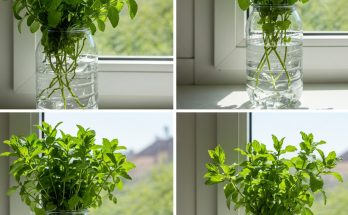Growing strawberries in pots is a rewarding and space-saving way to enjoy fresh, juicy berries right from your balcony, patio, or backyard. With the right container, care, and growing conditions, you can harvest sweet strawberries throughout the season—even if you don’t have a traditional garden. Here’s how to grow strawberries in pots to ensure a bountiful harvest.
Choosing the Right Strawberry Variety
The first step is selecting the right type of strawberry plant. There are three main types:
-
-
June-bearing: These produce a large harvest once a year, typically in late spring to early summer.
-
Everbearing: These produce two to three harvests throughout the season—one in spring, one in summer, and possibly one in fall.
-
-
Day-neutral: These can produce fruit continuously throughout the growing season as long as temperatures remain between 35°F and 85°F (1.5°C to 29.5°C).
For container gardening, day-neutral and everbearing varieties are the best choices because they provide a steady yield over time and are ideal for small-scale harvesting.
Selecting the Right Container
Strawberries have shallow roots, so you don’t need a deep pot, but you do need one with good drainage. Containers should be:
-
-
At least 12 inches (30 cm) in diameter
-
-
Equipped with drainage holes to prevent root rot
-
Made of plastic, clay, ceramic, or even hanging baskets
You can also use tiered strawberry planters or vertical grow bags to maximize space and sunlight exposure.
Preparing the Soil
Strawberries prefer slightly acidic, fertile, and well-draining soil. The ideal pH is between 5.5 and 6.5. For best results:
-
-
Use a high-quality potting mix rather than garden soil.
-
Mix in compost or well-rotted manure for added nutrients.
-
Optionally, blend in a handful of perlite or sand to improve drainage.
-
Avoid using soil that is too heavy or retains too much moisture, as strawberries are prone to root rot and fungal diseases.
Planting Your Strawberries
When planting strawberries in pots:
-
-
Space plants about 6–8 inches (15–20 cm) apart.
-
Plant the crown (the part where the leaves meet the roots) just above the soil line. Burying it can cause rot.
-
-
Water thoroughly after planting to help the roots settle.
If using runners or bare-root plants, soak the roots in water for about an hour before planting to rehydrate them.
Watering and Feeding
Strawberries in pots dry out faster than those in the ground, so consistent watering is essential. Keep the soil moist but not soggy. As a rule of thumb:
-
-
Water when the top inch of soil feels dry.
-
-
In hot weather, you may need to water daily.
Feed the plants with a balanced liquid fertilizer every two weeks. Once flowers appear, switch to a fertilizer high in potassium, such as one formulated for tomatoes, to encourage fruit production.
Sunlight and Temperature
Strawberries need at least 6–8 hours of direct sunlight daily. Place your pots in a sunny spot—ideally south-facing if you’re in the northern hemisphere.
Protect the plants from extreme heat and drying winds, especially during peak summer months. If temperatures get too high, move the pots to a semi-shaded area during the hottest part of the day.
Pollination Tips
Although strawberries are self-pollinating, they produce better yields when aided by bees or other insects. If pollinators are scarce, gently shake the flowers or use a soft brush to transfer pollen between blooms.
Mulching and Pest Control
Use straw, wood chips, or coconut fiber as mulch to keep the soil cool, conserve moisture, and keep the fruit clean.
Common pests include aphids, spider mites, and slugs. Monitor your plants regularly and remove pests by hand or use an organic insecticidal soap if necessary. To deter birds, consider using netting over the pots.
Pruning and Runner Management
Remove yellow or damaged leaves regularly to keep the plant healthy and productive. As strawberries grow, they’ll send out runners (long stems with baby plants at the end). In pots, it’s best to trim these runners so the parent plant focuses energy on producing fruit.
If you want to propagate new plants, you can root one or two runners in separate containers.
Harvesting Strawberries
Harvest strawberries when they are fully red, firm, and glossy. Pick them with the green cap attached to prolong freshness. Berries don’t ripen after picking, so don’t harvest them too early.
Frequent picking also encourages the plant to produce more fruit.
Final Thoughts
Growing strawberries in pots is not only practical but also fun and satisfying. With the right care—sunlight, water, feeding, and a bit of attention—you’ll enjoy delicious homegrown strawberries all season long. Whether on a windowsill, balcony, or patio, these vibrant plants add beauty and flavor to any space.

